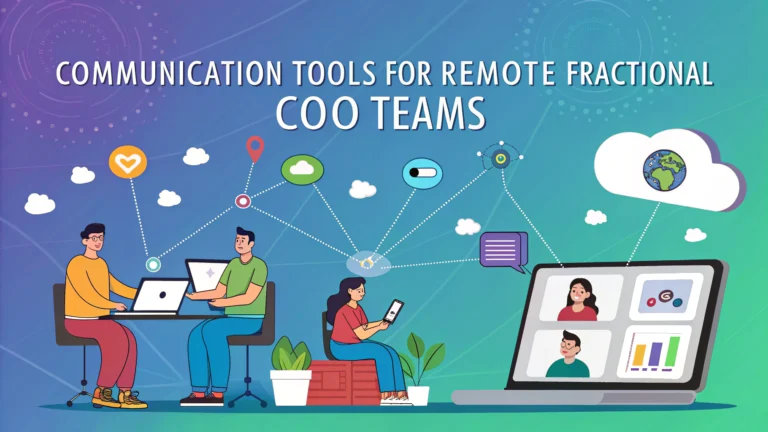Managing a remote fractional COO team requires robust communication tools to ensure smooth operations and effective collaboration across different time zones and locations.
The right mix of communication platforms can significantly improve team coordination, project management, and strategic execution for fractional COOs working with distributed teams.
This quick guide outlines the most effective communication tools and strategies for remote fractional COO teams, based on real-world implementation and success stories.
Core Communication Platforms
- Slack – Real-time messaging and file sharing
- Microsoft Teams – Integrated communication and collaboration
- Zoom – Video conferencing and virtual meetings
- Google Workspace – Document collaboration and email
Project Management Tools
- Asana – Task management and project tracking
- Monday.com – Visual project management
- ClickUp – Customizable workflow management
- Trello – Kanban-style project organization
Document Collaboration
- Google Docs – Real-time document editing
- Notion – Knowledge management and documentation
- Confluence – Team documentation and knowledge sharing
- Coda – All-in-one doc collaboration
Time Zone Management
- World Time Buddy – Time zone coordination
- Every Time Zone – Visual time zone comparison
- Calendar.io – Smart scheduling across time zones
Team Collaboration Best Practices
Set clear communication guidelines and response time expectations for different channels.
Schedule regular video check-ins to maintain personal connections and address complex issues.
Use asynchronous communication tools for non-urgent matters to respect team members’ work hours.
Document all important decisions and discussions in a centralized location accessible to all team members.
Security and Data Protection
- LastPass – Password management
- 1Password – Secure credential sharing
- Signal – Encrypted messaging
- ProtonMail – Secure email communication
Communication Tool Integration Tips
Select tools that integrate well with existing systems and workflows.
Prioritize platforms with strong mobile support for on-the-go access.
Choose tools with robust API capabilities for custom automation needs.
Building Your Communication Stack
| Category | Essential Tool | Alternative |
|---|---|---|
| Chat | Slack | Microsoft Teams |
| Video | Zoom | Google Meet |
| Project Management | Asana | Monday.com |
Moving Forward with Remote Communication
Regular evaluation and adjustment of communication tools ensure they continue meeting team needs and objectives.
Stay updated with new communication technology developments to maintain competitive advantage.
Consider team feedback when making changes to communication tools and processes.
Measuring Communication Effectiveness
Track key metrics to assess the impact of communication tools on team productivity and collaboration:
- Response Times – Average time to address team inquiries
- Project Completion Rates – Impact on delivery timelines
- Team Satisfaction – Regular feedback surveys
- Tool Usage Statistics – Adoption rates and engagement
Cost Management and ROI
- Tool Consolidation – Eliminate redundant platforms
- Subscription Optimization – Right-size user licenses
- Integration Costs – Factor in API and custom development
- Training Investment – Team onboarding and skill development
Crisis Communication Protocol
Establish clear emergency communication procedures:
- Priority Channels – Designated platforms for urgent matters
- Escalation Matrix – Clear decision-making hierarchy
- Backup Systems – Alternative communication methods
- Emergency Contacts – Updated team directory
Optimizing Remote Team Success
Remote fractional COO teams thrive with the right combination of tools, protocols, and practices. Regular assessment and adaptation of communication strategies ensure sustained effectiveness and team alignment.
Focus on building a communication ecosystem that promotes transparency, efficiency, and strong team relationships while maintaining security and operational excellence.
Remember that successful remote team communication is an ongoing journey of improvement and optimization, not a one-time implementation.
FAQs
- What are the essential communication tools needed for remote fractional COO teams?
The core tools include project management software (like Asana or Monday.com), video conferencing platforms (Zoom or Microsoft Teams), instant messaging (Slack or Discord), document collaboration tools (Google Workspace or Microsoft 365), and time tracking software (Toggl or Harvest). - How do fractional COOs maintain effective communication across different time zones?
They utilize asynchronous communication tools, implement clear communication protocols, use scheduling tools like World Time Buddy, maintain shared calendars, and establish core overlap hours for real-time collaboration. - What security measures should be in place for remote communication tools?
Essential security measures include multi-factor authentication, end-to-end encryption, secure VPN access, regular security audits, role-based access control, and compliance with data protection regulations like GDPR or HIPAA. - Which project management tools are best suited for fractional COO operations?
Popular options include Asana for workflow management, ClickUp for comprehensive project tracking, Monday.com for visual process management, and Trello for agile project management. - How can remote fractional COOs ensure clear documentation and knowledge sharing?
Through centralized documentation platforms like Notion or Confluence, standardized reporting templates, regular updates in project management tools, and organized digital file systems with clear naming conventions. - What collaboration tools are recommended for strategic planning sessions?
Virtual whiteboarding tools like Miro or Mural, strategic planning software like Cascade or AirTable, and collaborative presentation tools like Google Slides or PowerPoint Online are recommended. - How do fractional COOs track team productivity in remote settings?
They use time tracking software, project management metrics, KPI dashboards, regular check-ins through video calls, and performance monitoring tools like RescueTime or DeskTime. - What communication protocols should be established for emergency situations?
Emergency protocols should include designated emergency communication channels, escalation procedures, backup communication methods, emergency contact lists, and clear response time expectations. - How can fractional COOs ensure effective team alignment across remote operations?
Through regular virtual team meetings, shared OKR tracking tools, clear communication of company goals via platforms like 15Five or Lattice, and structured feedback systems. - What tools are recommended for financial reporting and analysis in remote settings?
Cloud-based financial tools like QuickBooks Online or Xero, reporting software like Tableau or Power BI, and collaborative spreadsheet platforms for real-time financial tracking.








